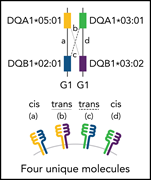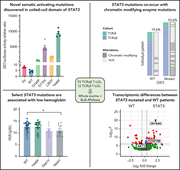Issue Archive
Table of Contents
BLOOD COMMENTARIES
PLENARY PAPER
HLA-DQ heterodimers in hematopoietic cell transplantation
Relapse after hematopoietic stem cell transplant (HSCT) remains the most common cause of mortality after HSCT. Previously, matching at the class 2 locus, HLA-DQ, has not been considered to be of major relevance to outcomes, but in this Plenary paper, Petersdorf et al demonstrate that specific heterodimers of HLA-DQ α and β chains are associated with higher rates of relapse and decreased disease-free survival. These findings may alter algorithms for HSCT donor selection and stimulate new investigations into the modulation of graft-versus-tumor activity.
SPECIAL REPORT
Hemochromatosis classification: update and recommendations by the BIOIRON Society
Recent advances in the knowledge of the pathophysiology and molecular basis of iron metabolism highlight that hemochromatosis is caused by mutations in at least 5 genes. In this Special Report, experts from the BIOIRON Society propose an updated classification that is clinically applicable and incorporates the complexity of available state-of-the-art molecular testing. The report also provides a valuable overview of iron-loading conditions that must be distinguished from hemochromatosis.
PERSPECTIVE
Revisiting anemia in sickle cell disease and finding the balance with therapeutic approaches
Xu and Thein provide a perspective that addresses the issue of anemia as a prime component of the morbidity and mortality of sickle cell disease (SCD). Emphasizing that the pathophysiology of anemia in SCD is more multifaceted than in other common anemias because of the vaso-occlusive nature of SCD, they argue that management must be more nuanced. Several established and emerging therapeutic approaches are evaluated, and a call for more focused research is made.
HEMATOPOIESIS AND STEM CELLS
Critical role of Lama4 for hematopoiesis regeneration and acute myeloid leukemia progression
The hematopoietic niche is disordered and plays a functional role in stress hematopoiesis and acute myeloid leukemia (AML). Cai and colleagues used murine models and human in vitro studies to show that Laminin α4 (Lama4), a major receptor-binding chain of several laminins, is required for normal recovery after myelotoxic irradiation and that its absence accelerates AML and confers resistance to therapy in AML stem cells. It raises the possibility that targeting Lama4 signaling pathways may have therapeutic potential.
LYMPHOID NEOPLASIA
Genomic landscape of TCRαβ and TCRγδ T-large granular lymphocyte leukemia
CME
In this month’s CME article, Cheon and colleagues report results of an integrated genomic approach to better define and classify large granular lymphocyte leukemia (LGLL) subtypes. By overlaying the STAT3 mutation status, the authors defined distinct molecular signatures, revealed the common co-occurrence of epigenetic regulator gene alterations, and identified STAT3 mutation-specific clinical associations for this uncommon neoplasm. These data help us better understand the clinical heterogeneity of LGLL.
Modifiable risk factors for neurocognitive and psychosocial problems after Hodgkin lymphoma
Clinical Trials & Observations
Although Hodgkin lymphoma is a rare disease, its high curability in children and young adults yields a large population of survivors. In this report from the Childhood Cancer Survivor Study, Williams et al reported a significant burden of neurocognitive, psychosocial, and quality of life impairments as well as the recognized morbidity and premature mortality consequent to treatment. Potentially modifiable factors like exercise, weight control, smoking avoidance, and management of hypertension are identified for future intervention.
THROMBOSIS AND HEMOSTASIS
Structural insights into collagen binding by platelet receptor glycoprotein VI
Platelet glycoprotein VI (GPVI) is a potential target for antithrombotics. Feitsma and colleagues report the first crystal structure of GPVI complexed with collagen-related peptide and propose the structural basis of GPVI clustering on collagen fibers. This information will enhance design and screening for selective inhibitors that directly inhibit collagen binding to selectively inhibit activation of platelets.
BLOOD WORK
CONTINUING MEDICAL EDUCATION (CME) QUESTIONS
-
Cover Image
Cover Image
![issue cover]()
Confocal image showing the distribution of megakaryocytes (green, CD41+) and blood vessels (red, laminin-111+ vessels; blue, SCA1+ arterioles) in a Lama4−/− mouse femur after irradiation. The vessel density and the megakaryocytes adjacent to blood vessels were reduced in Lama4−/− mouse bone after the irradiation. See the article by Cai et al on page 3040.
- PDF Icon Front MatterFront Matter
- PDF Icon Table of ContentsTable of Contents
- PDF Icon Back MatterBack Matter
- PDF Icon Editorial BoardEditorial Board
Advertisement intended for health care professionals
Email alerts
Advertisement intended for health care professionals









HLA-DQ + CD4 help = graft-versus-tumor effect